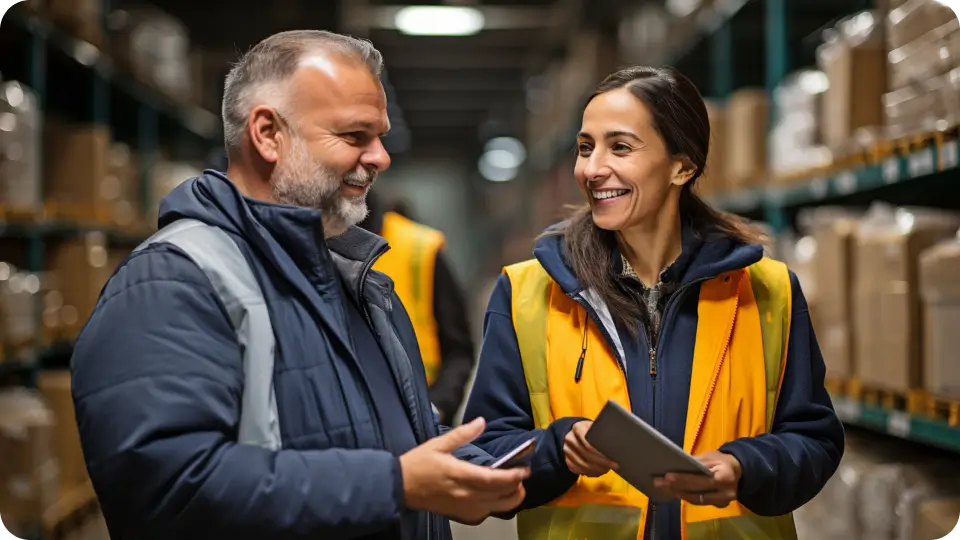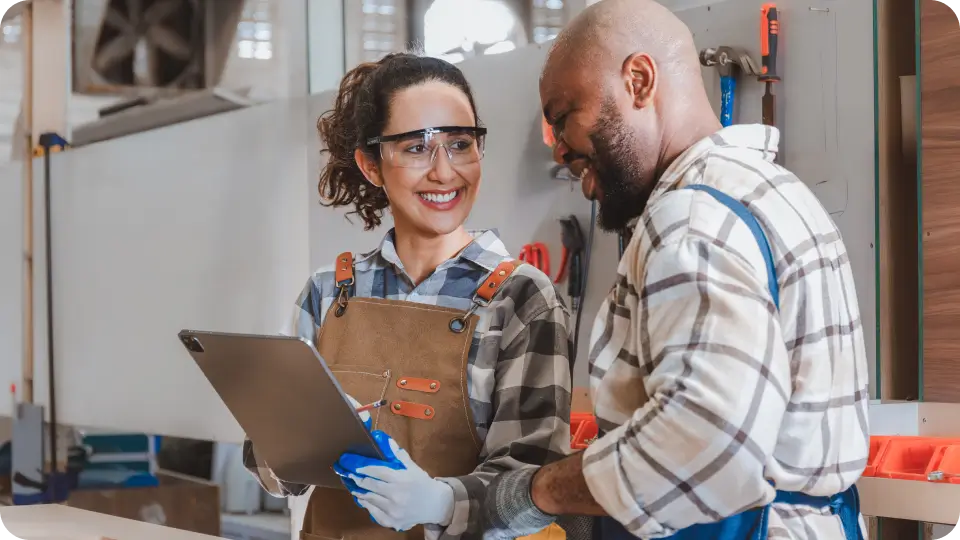When was the last time you picked up a paper manual when one of your household appliances went on the fritz?
If you’re like most of us, you likely didn’t even keep the paper manual when you purchased your new garbage disposal or washing machine. Instead, you’ll reach for your phone and search for a video on YouTube. You know it will turn up at least a handful of videos where someone has captured a few troubleshooting steps that will almost certainly help you fix the problem. In just a few minutes, you’ve fixed your appliance, and it was so much easier following along with a video with visual instructions and anecdotal tips. And we’re not the only ones who do this. A survey found that 91% of participants watched a video to understand how to use a physical product better.
In today's fast-paced manufacturing environment, the need for efficient, effective training solutions is table stakes to outpacing competition, maintaining production quality, and keeping workers safe. As technologies evolve and production processes grow more complex, manufacturers face the challenge of ensuring their workforce remains skilled and up-to-date. This is where video training emerges as a game-changer, offering a dynamic and impactful way to meet modern training needs. We should embrace the way people naturally want to learn and bring that preference for video into the workplace. DeepHow stands at the forefront of this, providing cutting-edge video training solutions that cater specifically to the unique demands of the manufacturing industry.
Video training, including safety training videos for manufacturing and video standard operating procedures (SOPs), represents a significant advancement over traditional training methods. By harnessing the power of visual learning, DeepHow is enabling manufacturers to enhance their training programs, improve operational efficiency, and foster a culture of continuous improvement and knowledge sharing.

The transition from traditional to modern training methods signifies a pivotal change in the skilled trades sector, underscoring a broader movement towards innovation and efficiency in workforce development. Traditional training techniques, characterized by long, in-person sessions and reliance on dense, text-heavy manuals, have shown their limitations in today's fast-paced industrial environment. Such methods not only demand significant time and financial resources but also fall short in addressing the varied learning styles present within a diverse workforce. In an era where skilled trades are becoming more complex and technology-driven, the need for more adaptable, engaging, and efficient training solutions is evident.
This shift reflects an understanding that the one-size-fits-all approach of the past is no longer viable in meeting the nuanced needs of modern employees. Workers today benefit from training that is visual, interactive, and can be accessed on-demand, allowing for a more personalized learning experience. Moreover, the evolving nature of skilled trades—with its continuous technological advancements and procedural updates—calls for training methods that can quickly adapt to new information and techniques.
Modern training approaches, particularly those leveraging video and digital platforms, offer the flexibility and scalability necessary to efficiently train employees, ensuring they remain competent in the face of industry innovations and changes. This evolution from old-school methods to modern, technology-driven training solutions marks a significant step forward in the way companies involved in skilled trades develop their most valuable asset: their people.
Enter video training—a more engaging, flexible, and accessible form of learning. Unlike the one-size-fits-all approach of the past, video training for manufacturers is designed to be interactive and easily digestible, catering to the visual and practical learning styles that are prevalent among today's employees. The appetite for modern training approaches is there: younger workers prefer learning through visual instructions, with 85% preferring videos over manuals.

Video training redefines the approach to skill development and SOPs in skilled trades. It goes beyond merely presenting information, offering an immersive learning experience that captures the complexity of manufacturing processes in a clear and comprehensible manner. The advantages are clear:
This modern approach to training has a profound impact on both the workforce and overall plant operations, promoting higher standards of efficiency, safety, and productivity.

The integration of video content into Standard Operating Procedures (SOPs) marks a transformative step in training within the skilled trades sector. Transitioning from traditional text-based documentation to video-enhanced SOPs offers a myriad of benefits, including clearer, more engaging instructions that facilitate easier comprehension, higher retention, and improved implementation. This shift not only leads to improved compliance and operational accuracy but also significantly enriches the learning experience for employees. By making complex information more digestible and engaging, video SOPs help ensure that critical knowledge is more effectively understood and retained by the workforce.
One of the most impactful advantages of video-enhanced SOPs is their ability to incorporate language translations and subtitles, making these training tools incredibly inclusive and videos able to be reused at multiple locations across different cultures. This feature is particularly beneficial in creating an environment that accommodates the diverse linguistic backgrounds of employees, ensuring that language barriers do not impede understanding or compliance. The addition of subtitles and translations means that employees who are non-native speakers of the primary business language can receive training in their preferred language, enhancing their ability to absorb and apply the information or even participate in creating new content.

Furthermore, the global reach of many organizations in the skilled trades sector necessitates a training approach that can be standardized across all sites while still accommodating local needs and languages. Video SOPs with language translations and subtitles fulfill this need perfectly, enabling organizations to globalize their training programs. This global applicability ensures consistency in training delivery and operational practices across international sites, fostering a cohesive and uniformly skilled workforce. It also means that the same high-quality training materials are accessible to every employee, regardless of their location, furthering the organization's commitment to quality and safety standards worldwide.
Mid-level managers play a pivotal role in ensuring the success of this transformation. They are responsible for overseeing the development of video SOPs that are not only concise and relevant but also thoughtfully designed to meet the specific know-how needs of their teams. This includes ensuring that videos are produced with clear, accessible language and that translations and subtitles are accurate and culturally sensitive.
By tailoring video SOPs to address the practical realities of the skilled trades floor and ensuring they are accessible in multiple languages, managers can guarantee that all employees, regardless of their linguistic background, can directly apply what they learn to their work. This approach not only improves operational efficiency and safety but also contributes to a more inclusive, knowledgeable, and cohesive workforce. According to Forbes, there are numerous benefits to an inclusive workplace, including better talent, happier employees, increased productivity, and more creative problem-solving, not to mention higher revenues.

A culture of knowledge sharing is not just beneficial but essential for the success of any operation within the skilled trades sector. In this context, video training platforms, particularly that offered by DeepHow, stand out as a revolutionary tool that dramatically enhances how knowledge is accessed, shared, and expanded upon within organizations. DeepHow's platform, with its cutting-edge Navigator and comprehensive knowledge library, exemplifies how technology can facilitate a seamless flow of information, thus accelerating the learning process and fostering a robust environment of collaboration and innovation.
DeepHow's Navigator feature is designed to make the search for information intuitive and efficient. It enables employees to quickly find specific video segments that address their immediate needs or questions. This capability is invaluable on the shop floor or in the field, where time is often of the essence, and the rapid application of knowledge can significantly impact productivity and safety. The Navigator ensures that employees spend less time searching for information and more time applying it, streamlining workflows and enhancing operational efficiency.
Furthermore, DeepHow's searchable knowledge library is a treasure trove of video training content that is meticulously organized and easily accessible. This library is not static; it grows and evolves, enriched by contributions from experts and users alike. It allows for the documentation of best practices, innovative techniques, and troubleshooting tips, making this collective intelligence available to all members of the organization. The library's design emphasizes ease of use, with sophisticated search functionalities that allow users to pinpoint the exact content they need, whether they're looking for a broad overview of a topic or a detailed walkthrough of a specific procedure. The user experience should feel familiar - it is very much like that of Netflix or YouTube, showing videos as thumbnails and suggesting related content.

What sets DeepHow's platform apart is its commitment to making knowledge sharing not just possible but also practical and engaging. By allowing employees to contribute their expertise and insights, it creates a dynamic, ever-expanding repository of information. This approach not only democratizes knowledge within the organization but also empowers employees by valuing their contributions and encouraging a culture of continuous learning and improvement.
In fostering a sense of collaboration and teamwork, DeepHow's video training platform and its features, like the Navigator and knowledge library, drive improvements across all levels of the organization. They do so by ensuring that valuable knowledge is not siloed but shared widely, leading to collective advancements in efficiency, innovation, and competency. This environment not only benefits the organization in terms of improved processes and outcomes but also contributes to a more engaged, motivated, and skilled workforce, prepared to meet the challenges of today and tomorrow.
DeepHow stands at the forefront of revolutionizing training in the skilled trades sector, offering innovative solutions tailored to meet the dynamic needs of this evolving field. By harnessing the power of video training and video-enhanced Standard Operating Procedures (SOPs), DeepHow equips organizations with the tools necessary to significantly boost learning outcomes, streamline operational efficiency, and cultivate a workforce that is both knowledgeable and productive. The impact of DeepHow's video training solutions has been widely recognized, with case studies from various organizations showcasing the tangible benefits of this modern approach to training, including well known brands such as Anheuser-Busch and Stanley Black & Decker.


DeepHow's innovative approach to training within the skilled trades sector showcases the power of video training and digital SOPs in transforming how knowledge is transferred, skills are developed, and operations are conducted. The success stories from organizations like ISAIC underscore the platform's ability to deliver significant improvements in efficiency, safety, and employee engagement, marking a new era in workforce development for the skilled trades.
As we reflect on the transformative journey of training within the skilled trades sector, it's clear that the future is now, and it's digital. The adoption of video training and digital SOPs by organizations like ISAIC, as showcased in DeepHow's compelling case studies, marks a significant milestone in the evolution of workforce development. These advancements offer a vivid glimpse into a future where training is not only more efficient and accessible but also more engaging and inclusive.
The shift towards video training in skilled trades is a response to the changing landscape of learning preferences and the technological advancements in our world. Just as we turn to video tutorials for quick fixes at home, DeepHow leverages this intuitive learning format to address complex training needs in the workplace. This evolution signifies a deeper understanding of how people learn best and the integration of these insights into practical, impactful training solutions.

The evidence is clear: the integration of video training and digital SOPs is not just a trend but a transformative shift in how knowledge is conveyed and skills are developed. DeepHow's pioneering approach, underpinned by success stories from various organizations, highlights the immense potential of video training to enhance learning outcomes, operational efficiency, and employee engagement.
The journey towards adopting these innovative training solutions is an exciting opportunity for organizations to not only meet the evolving needs of their workforce but also to lead the way in shaping the future of the skilled trades sector. As we move forward, embracing these digital tools will be key to developing a more knowledgeable, skilled, and engaged workforce ready to tackle the challenges of today and tomorrow.

Start capturing, structuring, and activating your expert
knowledge today with a 14-day unlimited free trial.